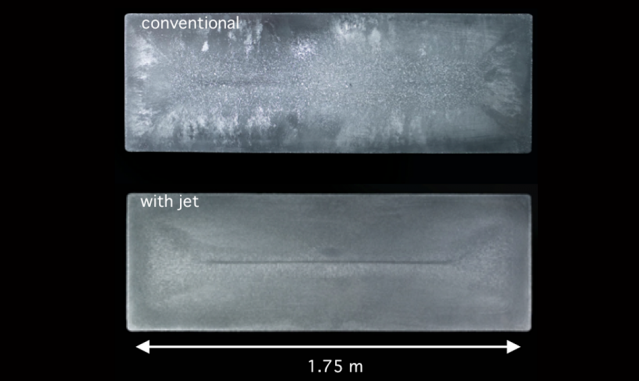
Agitating the aluminum pot
MIT researchers demonstrate that strong churning during hot liquid state can produce stronger, more uniformly structured large aluminum casts.
Denis Paiste | Materials Processing Center
December 8, 2016
Industrial aluminum slabs are typically produced by blending small amounts of copper or manganese in a reservoir of molten aluminum that is rapidly cooled, a process known as direct-chill casting. Variations in the way these elements solidify can yield uneven results that weaken the final product, with castings sometimes ending on the scrap heap. Controlling the distribution of strengthening elements to aluminum throughout a casting is thus key to reducing waste and improving product reliability.
Over the past three years, MIT assistant professor of metallurgy Antoine Allanore and his student Samuel R. Wagstaff PhD ’16 developed a new process that uses a turbulent jet to reduce this uneven distribution in aluminum alloy structures by 20 percent. The researchers were able to pinpoint a single number — the “macrosegregation index” — that quantifies the difference between the ideal chemical makeup and the actual chemical makeup at specific points in the solidification process.
“We have now tested the technology all along the supply chain, and we did confirm that the 20 percent improvement in macrosegregation index was good enough to allow further increase in productivity,” Allanore says.
Wagstaff’s and Allanore’s experimental results and theoretical explanations on direct-chill aluminum processing are published in a pair of articles in the journal Metallurgical and Materials Transactions B, with a third pending publication. The work was done in collaboration with global aluminum processor Novelis, with all the experiments taking place at Novelis Solatens Technology Center in Spokane, Washington; some aspects of the research have been patented.
Fighting unbalanced structures
Macrosegregation is the uneven distribution of alloying elements within a solidified aluminum part, creating, for example, copper-poor regions. This is most likely to occur in the center of a casting, where it remains hidden until the casting is reprocessed for another use such as rolling a thick slab into a flat sheet. These unbalanced structures can form on a scale from several fractions of an inch to several yards and they can lead to cracking, shearing or other mechanical failure of the material.
This issue is particularly significant as industry moves toward faster production schedules and larger sheet metal runs — for example, parts for pickup trucks and airplane wings. Greater emphasis on aluminum recycling also poses issues where the composition of secondary elements may be unpredictable.
“Analyzing the structure, and in particular the presence of solid grains, formed as the aluminum alloy turns from liquid to solid is difficult because you cannot see through aluminum, and the material is rapidly cooled from 700 degrees Celsius (1,292 degrees Fahrenheit), and differently sized grains are moving as the aluminum solidifies at the rate of about 2 to 3 inches per minute, Allanore says. The problem is typically a lack of the alloying element near the center of the solidifying slab or ingot.
“It’s a very perverse situation in the sense that from the outside the solid slab could look very nice, ready to go to the next treatment, and it’s only later on that you discover that there was this defect in a section, or in an area, which basically means a huge loss of productivity for the entire supply chain,” Allanore explains.
Making uniform alloys
“In our experiments, we did some specific tests at full scale to quench, so to basically sample the molten metal as it’s cast, and we’ve seen grains anywhere between 10 microns up to 50 microns, and those grains are, according to our development, the ones responsible for macrosegregation,” Allanore says. Their solution is inserting a jet stream to recirculate the hot liquid so those grains get redistributed uniformly as opposed to accumulating in one region of the ingot. “It’s like a hose of water in a swimming pool,” he explains. “From a purely fluid mechanics perspective, the mixture is homogeneous. It’s just a full, complete mixture of the alloying elements and aluminum.”
“The introduction of the jet induced a completely different recirculation of the grains and therefore you get different microstructure, all along the section. It’s not just on the edges or not just in the center, it’s really across the entire section,” Allanore says. The researchers were able to calculate the optimal jet power needed for the most common aluminum alloys, and then tested their predictions.
“Professor Allanore’s work is an excellent example of application of solidification theory to solution of a real world industrial problem,” says Merton C. Flemings, the Toyota Professor Emeritus of Materials Processing at MIT.
Steeped in metal work
Sam Wagstaff, lead author of the three papers with Allanore, finished his doctorate at MIT in September after just three years and now works for Novelis in Sierre, Switzerland. “The reason why this project is successful is, of course, because of Sam Wagstaff,” Allanore says. “He’s been an amazing graduate student.” Wagstaff, 27, is a great-grandson of George Wagstaff, and grandson of William Wagstaff, whose Spokane, Wash., area machine shop grew into Wagstaff Inc., which specializes in the chillers used to produce solid aluminum alloys from molten liquid (but which was not involved in this research). Sam Wagstaff’s father, Robert, works for Novelis, and Sam himself first worked for Novelis at age 14. After he earned his bachelor’s degree in mechanical and aerospace engineering at Cornell University, Novelis offered Wagstaff the opportunity to pursue a PhD to help the company solve the problem of macrosegregation by developing a method to stir aluminum.
“Being in an environment [in which Novelis is] okay with me taking the project and at the same time MIT letting me take it wherever I felt it needed to go, it ended up being an amazing experience,” Wagstaff says. “I don’t know of too many other companies or places that would have let me grow as much as I did, and for that I’m really grateful,” Wagstaff says.
“The problem you have with aircraft-grade or aerospace-grade plate is you have very significant macrosegregation regions in the center of that plate, so you have drastic drops in mechanical properties in the very center,” Wagstaff says. “Our research started with the idea we want to be able to stop macrosegregation,” Wagstaff says. Instead of studying many different ways to stir aluminum, Wagstaff says he and Allanore proposed developing a mixing criterion just like those used in chemical engineering. Because the worst problems were occurring in the center of ingots, with up to 20 percent variation in composition there, that became the focus of the research, he says.
“We knew we could figure out how to mix things up and we could stir things around, but being able to compare A to B to C would have been really difficult, and so that’s where the macrosegregation index came from. That’s just a numerical scheme that we invented to compare type A mixing to type B mixing to type C mixing, so then we can somehow relate all of the different mixing parameters together to say this kind of mixing is better,” he says. The index punishes ingots depending on their deviation from the desired composition as a function of their distance from the center and a lower index number represents higher quality.
The solution was to design a jet that would work with existing direct-chill casting machines. “All we did was change the jet power as a function of diameter using a magnetic pump to control speed, power and velocity of that jet throughout the casting,” Wagstaff says. “The great thing about jets is they are pretty well defined, we understand how they expand, how their forces are distributed as a function of time, as a function of space, so they are a relatively easy phenomenon to study. We ended up coupling magnets with the jet and built a non-contact magnetic pump to generate our jet.”
Optimizing jet power
The team developed formulas to calculate how fast and how strong the jet power has to be to prevent clustering of defects in the center for a given set of alloying elements and mold dimensions. While the papers report improvement of 20 percent, Wagstaff says with optimization of the jet pump, improvement up to 60 percent is possible.
Small variations in individual grains [microsegregation] can sometimes be healed by reheating the aluminum casting, but when large-scale uneven distribution occurs with a weak centerline, it is impractical because it would take far too long for the copper or other alloying element to migrate through the material.
Materials science graduate student Carolyn M. Joseph in Allanore’s group is studying how these grains that cause macrosegregation form in an aluminum alloy that is 4.5 percent copper by weight. Using the new jet stirring technique, she takes samples during casting near the two-phase region (slurry), in which grains of solid metal circulate in the liquid aluminum. She does this by rapidly cooling the metal at various locations along the ingot as it is being formed, and she studies the samples under a microscope for differences in grain size, shape, composition and distribution. “The size of your solid structure, how fine or coarse it is, depends on the rate at which you’re cooling it,” Joseph explains. Microscopic images she made of samples showing large grain structures are evidence those grains were solid in the slurry before it was rapidly cooled, she says.
“In the liquid, they are mixed, the cooper and aluminum form a solution, but when you go from liquid to solid, there is segregation of the alloying elements,” Joseph says. Grains that form early are depleted in copper and tend to cluster in the center of a slab.
“The advantage of this is that it’s an intermediate type of snapshot. Instead of looking at the final cross-section and studying its grain size and composition, we can see it at an intermediate stage, while it’s a semi-solid mixture, what’s going on,” explains Joseph, who is working toward a master’s degree in materials science. “On the macroscale, you want an even distribution of copper, and that’s what Sam’s mixing has been able to achieve,” she says.
Role in recycling
Allanore believes the jet-stirred aluminum process can also play a role in recycling. “Not all recycled products of aluminum are the same, because some of them come from a former plane and some of them come from a former beverage can, and these are two different alloys,” he says. “So when it comes to society being able to recycle and make new aluminum products of high-quality, we can clearly see that there is an issue of how are we going to deal with those alloying elements. The work that we have done, I believe, is one example of how we can modify existing technologies so that they become more ready to have more recycled material without compromising at the end with the quality of the product that you are making.”
“By doing the proper amount of theoretical work and experimental work and working in collaboration, hand-in-hand with industry, we can find these type of solutions that allow higher productivity, more recycled materials which means less energy and less environmental impact, something very exciting,” Allanore says.







Leave a Reply